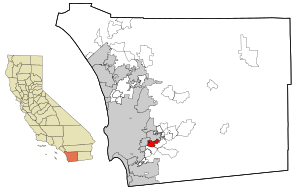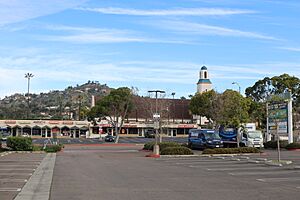Casa de Oro-Mount Helix, California facts for kids
Quick facts for kids
Casa de Oro-Mount Helix
|
|
|---|---|

Location in San Diego County and the state of California
|
|
| Country | |
| State | |
| County | |
| Area | |
| • Total | 6.85 sq mi (17.74 km2) |
| • Land | 6.85 sq mi (17.74 km2) |
| • Water | 0.00 sq mi (0.00 km2) 0% |
| Population
(2020)
|
|
| • Total | 19,576 |
| • Density | 2,857.39/sq mi (1,103.25/km2) |
| Time zone | UTC-8 (Pacific) |
| • Summer (DST) | UTC-7 (PDT) |
| ZIP codes |
91941, 91977, 92020
|
| Area code | 619 |
| FIPS code | 06-11691 |
| GNIS feature ID | 2407979 |
Casa de Oro-Mount Helix is a special community in the East County area of San Diego County, California. It's called a census-designated place (CDP). This means it's an area that the government tracks for population, but it's not officially a city or town.
This CDP includes several neighborhoods that are not part of a city. These neighborhoods are close to the cities of El Cajon and La Mesa. They are also near another CDP called Spring Valley. If you live in the northern part, called Mount Helix, your mail might say La Mesa. If you live in the southern part, Casa de Oro, your mail might say Spring Valley. Many people think of Casa de Oro as part of Spring Valley.
Contents
History of Casa de Oro-Mount Helix
The story of Casa de Oro-Mount Helix began in 1872. A scientist found a special European snail, called Cornu aspersum, living on a small mountain. Because of this snail, Rufus King Porter named the peak Mount Helix. Rufus Porter was also the founder of what is now Spring Valley, California.
In 1885, the United States Postal Service said that post office names could only be one word. So, Rufus changed the name to just Helix. He also became the first postmaster in Spring Valley, running the Helix Post Office from his own home.
Around the same time, a person named Hubert Howe Bancroft came to the area. He bought Rufus Porter's ranch and other nearby lands. He ended up owning about 500 acres (2 square kilometers). Bancroft called his property "Helix Farms." He hired people to help him develop the farm. They planted many fruit trees and built structures for the ranch.
By the early 1900s, Helix Farms became the largest olive ranch in southern California. You can still find some of the original olive trees there today! Bancroft passed away in 1918, and his family later sold the property.
Geography of the Area
Casa de Oro-Mount Helix is located at 32°45′48″N 116°58′39″W / 32.76333°N 116.97750°W. This means it's in a specific spot on the map.
The United States Census Bureau says that the total area of this community is about 6.9 square miles (17.7 square kilometers). All of this area is land, with no large bodies of water.
Population and People
| Historical population | |||
|---|---|---|---|
| Census | Pop. | %± | |
| 2000 | 18,874 | — | |
| 2010 | 18,762 | −0.6% | |
| 2020 | 19,576 | 4.3% | |
| U.S. Decennial Census 1850–1870 1880-1890 1900 1910 1920 1930 1940 1950 1960 1970 1980 1990 2000 2010 |
|||
Population in 2010
The 2010 United States Census counted 18,762 people living in Casa de Oro-Mount Helix. This means there were about 2,738 people per square mile (1,057 people per square kilometer).
Most people in the area were White, making up about 64.6% of the population. Other groups included African American (5.9%), Asian (3.2%), and Native American (0.5%). About 23.3% of the people were of Hispanic or Latino background.
Most people, about 98.9%, lived in regular homes. There were 6,943 households in total. About 31.4% of these households had children under 18 living there. The average household had about 2.67 people.
The population was spread out by age. About 21% of the people were under 18 years old. About 18.6% were 65 years or older. The average age in the community was 45.4 years.
Population in 2000
In the census of 2000, there were 18,874 people living in Casa de Oro-Mount Helix. There were 7,012 households.
The racial makeup was similar to 2010, with about 68.7% White. About 17.2% of the population was Hispanic or Latino.
The average income for a household in 2000 was about $60,387 per year. For families, the average income was about $72,127.
Education in the Community
Students in Casa de Oro-Mount Helix attend public schools. High school education is provided by the Grossmont Union High School District. Younger students, in elementary and middle school, go to schools run by the La Mesa-Spring Valley School District.
See also
 In Spanish: Casa de Oro-Mount Helix para niños
In Spanish: Casa de Oro-Mount Helix para niños
Images for kids




